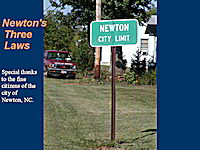Target shoot: Ball on ramp, conservation of energy
 Many physics teachers do a “target shoot” lab for conservation of energy. The basics of the lab is that students roll a ball down a curved ramp and predict where it will land. By calculating the change in gravitational energy from the top to the bottom of the ramp (“Phase A” in the sketch), students can use this as the kinetic energy at the top of the drop (“Phase B” in the sketch) and calculate the velocity of the ball (at this point all horizontal). They then calculate the distance the ball will land from the table.
Many physics teachers do a “target shoot” lab for conservation of energy. The basics of the lab is that students roll a ball down a curved ramp and predict where it will land. By calculating the change in gravitational energy from the top to the bottom of the ramp (“Phase A” in the sketch), students can use this as the kinetic energy at the top of the drop (“Phase B” in the sketch) and calculate the velocity of the ball (at this point all horizontal). They then calculate the distance the ball will land from the table.
The key is they don’t get the ball until they are ready to take the test (otherwise some will roll it down the ramp and record where it lands). You can either give them the mass of the ball, or point out to them that both gravitational and kinetic energy use mass, so it can be canceled out when you set Eg = Ek
Note: I use the Modeling Instruction symbolism “Ek” etc. instead of KE, to emphasize to students that all energy is the same, just stored in different means–this symbolism follows standard physics/science symbolism of using a large letter for this concept (e.g. Energy, Friction), and adding a subscript for the different types (e.g. kinetic and static for friction, kinetic, gravitational, elastic for energy).
 I first did this with a cup with clay in the bottom. Students would place the cup where they predicted the ball would land, then roll the ball down and see if they were accurate. But I’ve since come up with a target with grade letters on it. Once the make their calculations of where the ball will land, they carefully line up the ramp with their target (I put + and – sideways on the target, since this “lining up” is more eyeball than physics). Once they have their target taped on the floor, I come around with a piece of carbon paper (many students have not seen this before) and place it on top of the target. I then roll the ball off the ramp three times, and they get the average of the three results (usually all three dots are very close to each other). It’s always great to see their faces as the carbon paper is lifted and they get to see their grades!
I first did this with a cup with clay in the bottom. Students would place the cup where they predicted the ball would land, then roll the ball down and see if they were accurate. But I’ve since come up with a target with grade letters on it. Once the make their calculations of where the ball will land, they carefully line up the ramp with their target (I put + and – sideways on the target, since this “lining up” is more eyeball than physics). Once they have their target taped on the floor, I come around with a piece of carbon paper (many students have not seen this before) and place it on top of the target. I then roll the ball off the ramp three times, and they get the average of the three results (usually all three dots are very close to each other). It’s always great to see their faces as the carbon paper is lifted and they get to see their grades!
Rotational energy
One caution on this lab: about 25% of the gravitational energy is converted to rotational energy, so the results are not where they predict. In my class, I simply point out to students that to get a ball rotating, work is required and thus some of the gravitational energy is converted into this rotational energy. In their calculations, they deduct this 25%, and their results are excellent. With more advanced classes, students could calculate the rotational energy themselves.
Handouts
Below are the handouts I use with my students. The tutorial walks them through the process, so you may or may not want to provide it to your students.
The tutorial assumes that students have learned that the angle of the ramp doesn’t matter, only the height that the ball falls.




Hi Lee,
I’m going to use your activity and target. In 15 years of teaching, I’ve always wanted to do this activity and I’m finally doing it with my summer physics class.
Aaron